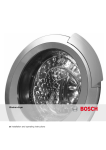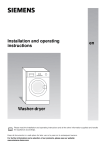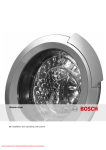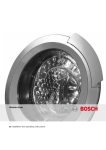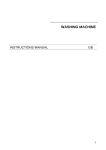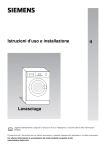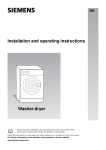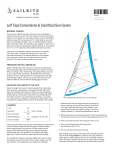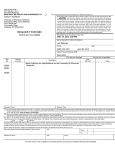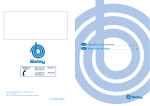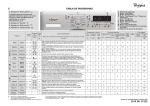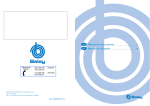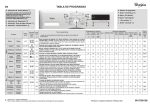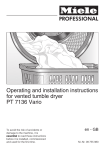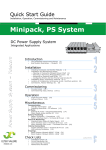Download BALAY 3TI60081A Installation Manual
Transcript
Installation and operating instructions en Washing machine Please read the installation and operating instructions and all the other information supplied and handle the appliance accordingly. Keep all documents in a safe place for future reference, or to pass on to the next owner. For further information and a selection of our products, visit our website: http://www.balay.es Table of contents Operating instructions Installation instructions Appendix General safety information ......................................................... 3 Environmental protection/economy tips .................................. 4 Your new washing machine ....................................................... 5 Before washing for the first time ............................................... 7 Preparing and sorting the laundry ............................................ 7 Detergents and care products ................................................... 9 Programmes ...............................................................................11 Washing options ........................................................................12 Washing .......................................................................................13 Cleaning and care .....................................................................15 What to do if... ............................................................................18 After-sales service .....................................................................21 Installation instructions .............................................................22 Table of programmes ...............................................................27 Consumption rates ....................................................................28 Index .............................................................................................29 2 General safety information This washing machine is intended: – exclusively for domestic use. – for washing machine-washable fabrics and hand-washable woollens in detergent solution. – for operation using cold drinking water and standard detergents and care products which are suitable for use in washing machines. Intended use This washing machine complies with relevant safety regulations. – Risk of electric shock. – To remove the mains plug, only pull directly on the plug itself, not on the plug cable. – Never insert or pull out the plug if your hands are wet. – Risk of suffocation. Keep packaging, plastic film and packing parts out of the reach of children. – Danger of death. When appliances have reached the end of their service life, pull out the mains plug. Cut off the mains cable and remove it with the plug. Destroy the loading door lock. Children cannot then lock themselves in and put their life in danger. – Risk of poisoning. Keep detergents and care products out of the reach of children. – Risk of explosion. After being placed in the washing machine, items of laundry which have been pretreated with cleaning agents containing solvent (e.g. stain remover or cleaning solvents) may cause an explosion. Hand-rinse items of laundry thoroughly beforehand. – Risk of injury. – The loading door can become very hot. – Exercise caution when emptying hot detergent solution. – Do not climb onto the washing machine. – Do not lean on the loading door when it is open. – Do not reach into the drum if it is still turning. Hazard warnings Before using for the first time – Install the washing machine according to the installation instructions page 23. – Remove the transport locks and keep them in a safe place. – Do not operate the washing machine if it shows visible signs of damage. If you are in any doubt, please consult with the after-sales service or your dealer. – Remove all objects from pockets, paying particular attention to sources of ignition (e.g. lighters, matches, etc.). – Do not leave children unsupervised near the washing machine. – The washing machine must not be used by children or persons who have not been instructed in its use. – Keep pets away from the washing machine. – Exercise caution when emptying hot detergent solution. – The door can become very hot during operation. When washing To protect the washing machine WEEE ) – Do not climb onto the washing machine. – Do not lean on the door of the washing machine when it is open. – Do not install the washing machine in an area which is prone to frost because hoses may burst or tear if they freeze. – Do not transport the washing machine without the transport locks in place. This appliance is designated according to European Directive 2002/96/ EC, which governs waste electrical and electronic equipment - WEEE). The directive provides a framework for the return and recycling of used appliances, which is applicable across the EU. 3 Environmental protection/economy tips – Separate out the various waste materials of the packaging and take them to the nearest collection point. – Always fill the appliance with the maximum amount of laundry for each programme. – Wash normally soiled laundry without a prewash. – Instead of the resistentes algod. (Cottons) 90 °C programme, select resistentes algod. (Cottons) 60 °C extra (intensive) page 11. Comparable cleaning with considerably lower energy consumption. – Measure the detergent according to the manufacturer's instructions and in line with the local water hardness. – If the laundry is subsequently dried in a tumble drier, select the spin speed according to the tumble drier manufacturer's instructions. 4 Your new washing machine Description of the washing machine You have chosen to buy a modern, high-quality Balay domestic appliance. A distinctive feature of your washing machine is its low energy consumption. Every machine which leaves our factory is carefully checked to ensure that it operates correctly and is in perfect condition. N.B.: The water inlet hose and water outlet hose must be correctly attached during washing page 25. The water tap must be turned open. Loading door A safety device prevents the door from being opened during operation. Before opening Make sure that there is no water in the drum and that the drum is not moving. Emergency release In the event of a power cut, the door can be released mechanically page 20. 5 Control panel Indicator lights for programme progress Shows the programme progress and the programme status. Operating condition Function selection buttons with indicator lights Show the selected settings: – $ flot: Rinse stop * centrif.: reduce maximum spin speed by – 200 rpm (*depending on model). & Function selection buttons ! inicio/ pausa ! inicio/pausa (start/pause) button page 12. Starts the selected programme. – Reset function: Resets to the original settings page 14. Programme selector Programme selector page 11 Switches the washing machine on and off and for selecting the programme, turnable in both directions. Do not change the position of the programme selector during washing. 6 Before washing for the first time The washing machine was tested before leaving the factory. In order to remove any testing water which may be remaining, run the first washing cycle without any laundry. Make sure that the transport locks on the back of the washing machine have been removed page 23. Do not load any laundry. Close the loading door. Turn on the water tap. Pull out the detergent drawer. Add ½ a measuring cup of detergent to compartment II page 9. i i Do not use detergents for woollens or delicates (these cause foaming). Close the detergent drawer. Turn the program selector to a 60°C programme. Press the ! inicio/pausa (Start/Pause) button. At the end of the programme, set the programme selector to stop (Off). Open the door. Leave the loading door open in order that the inside of the washing machine can dry. Preparing and sorting the laundry Sorting laundry for washing i – Check the manufacturer's care instructions and care labels. The laundry may be damaged if you do not observe the fabric care symbols. Knitwear made of wool or which contains a proportion of wool must have the label “machine-washable”. – Wash white laundry separately from coloureds. – Sort according to type, colour, level of soiling and temperature. New coloured laundry should be washed separately. Risk of discolouration. – Unhemmed or torn items should not be washed in the machine, as they may fray. – Do not exceed the permissible load capacity page 27. 7 Sorting laundry according to the information on the care labels Only wash laundry with the following care labels: Care label Type of laundry <; Cottons 90 °C. :98 Coloureds 60 °C, 40 °C, 30 °C. BA> Easy-care 60 °C, 40 °C, 30 °C. uFAE> Hand- and machine-washable silk and wool, cold, 40 °C, 30 °C. Laundry with care symbol Preparing laundry for washing Loading the laundry Do not wash. Loose foreign bodies (e.g. coins, paper-clips, needles, nails) may damage the laundry and components of the washing machine (e.g. the drum). Empty the pockets of all items. Brush any sand out of pockets and collars. Pretreat any stains. Close zips, do up cover buttons. Remove curtain fittings or place curtains in a laundry bag. Wash the following in a laundry bag/pillowcase: – Delicates, (e.g. tights, curtains), – small items of laundry (e.g socks or handkerchief), – underwired bras (the underwiring may come loose during the washing process and cause damage). Turn trousers, knitwear and jersey fabrics, e.g. hosiery, T-shirts or sweatshirts, inside out. Before loading the washing machine, make sure that there are no inappropriate objects or pets in the drum. Risk of explosion. Items that have been pretreated with cleaning agents containing solvents, e.g. stain remover or stain solvent, must be carefully rinsed by hand before they are loaded into the machine. Unfold the laundry and place it loosely into the drum. Load large and small items together. Check the maximum drum loads, programme table page 27. Take care not to trap items of laundry between the door and the rubber seal. Close the door. You will hear it click shut. Measure out appropriate amounts of detergent and care products and pour into the machine. Turn on the water tap. 8 Detergents and care products The detergent drawer is divided into three compartments Detergent drawer Compartment I : Detergent for prewash. Compartment II : Detergent for main wash. Compartment i : Liquid additives such as starch and fabric softener. Additives are automatically flushed into the machine during the last wash cycle. I II i – Do not exceed the maximum capacity, otherwise compartment i may be emptied too early. – Dilute viscous additives with water before adding them to the detergent drawer compartment to prevent blockages. Liquid detergent insert: must be folded down before liquid detergents are used. To do this: Pull out the detergent drawer as far as the stop. Press on the blue zone marked PUSH and fully remove the detergent drawer page 15. Pull the blue insert in compartment II fully forward and fold downwards. Insert the detergent drawer. Do not use the insert (push upwards): – with gel-type detergents and washing powder, or – if using programmes with +Prewash. Risk of poisoning Keep detergents and care products out of the reach of children. Detergents and care products Risk of injury Exercise caution when opening the detergent drawer. There may still be detergent residues left in the drawer. Select the correct dosage for the detergent according to: – the amount of laundry, – the instructions of the detergent manufacturer, – how dirty the laundry is, – water hardness. You can find out about the water hardness in your area from your local waterworks. i Using the correct dosage reduces the impact on the environment and gives a good washing result. 9 Normally soiled laundry Measuring washing powder Set the programme. Add all the detergent, according to the manufacturer's instructions, to compartment II of the detergent drawer. i – Only use pH-neutral wool detergent for woollens programmes. – Add fabric softener to compartment i. Heavily soiled laundry Set programme with prewash. Add 1/4 of the recommended amount of detergent to compartment I of the detergent drawer and 3/4 of the detergent to compartment II. Only use liquid detergent for the main wash cycle. Measuring liquid detergent To do this: Add the recommended amount of detergent to a liquid detergent measuring aid and place it in the drum. or After folding down the liquid detergent insert, pour the detergent into compartment II of the detergent drawer. i Use the scale on the liquid detergent insert as a guide for the dosage of liquid detergent. i If compartment II is used for washing powder, the liquid detergent insert must be folded up. 10 Programmes Programme selector Washing programmes (*Depending on model) The programme selector is used to set the washing and drying programmes. resistentes algod. (Cottons) Suitable for hard-wearing fabrics, heat-resistant fabrics made from cotton or linen. – Coloureds up to 60 °C. – Whites 60 °C up to 90 °C. resistentes algod. (Cottons) 60°C extra (Intensive) Energy-saving programme. Because of the extended washing time which also consumes considerably less energy, a level of cleaning comparable to the 90°C programme is achieved. resistentes algod. (Cottons)+ prelav. (Prewash) for heavily soiled laundry with additional prewash. sintéticos (Easy-care) (cold*, 40°C, 60°C) Washing programme for less robust fabrics made of cotton, linen, synthetic fibre or blended fabrics. Sorting by colour is recommended. delicado (Delicates) frio (cold*) Low heat programme for delicate, washable fabrics, e.g. made of silk, satin, synthetic fibre or blended fabrics (e.g. curtains). Gentle spinning between wash cycles and reduced final spin speed. lana/la u(Wool) (cold*, 30°C) Wool becomes matted under the influence of heat, moisture and movement. The woollens programme takes account of these properties and finds the optimum way between drum standstill and movement. Suitable for hand- or machine-washable fabrics made from wool or a wool blend. Special programmes O / C (Rinse + Spin) Wash cycle followed by spinning. Fabric softener or starch can also be used in this programme. C (Spin) Separate spin cycle; Detergent solution or water used for rinsing are emptied before the spin cycle starts. t/D (Empty) Emptying of the water used for rinsing without final spin cycle after selecting a washing programme with the setting D (Rinse stop). 11 Washing options Button & centrif. Unbalanced load detection system The maximum spin speed* (*depending on model, programme table page 27) is reduced by 200 rpm. This programme reduces the formation of creases. By repeatedly starting and stopping drum spinning, the unbalanced load detection system ensures that the laundry is evenly distributed. For safety reasons, the speed of the final spin is reduced or the spin cycle is not run if the laundry is very unevenly distributed. $ flot button (Rinse stop) The laundry remains in the last water used for rinsing. Suitable for delicate fabrics and curtains page 13 ! inicio/pausa button Press ! inicio/ pausa (Start/Pause) to start the selected programme. (Start/Pause) Programme progress Display of programme progress by indicator lights lighting up: preparado (ready) lavado (wash) - After switching on the washing machine, the indicator lights lavado (wash) (preparado (ready)) flash. - When the programme is started, lavado (wash) remains constantly lit. aclar / enxag. (rinse) - The light remains lit during rinsing. - Rinse stop selected: all indicator lights are switched off. Button < centrif. (Rinse stop) flashes. & centrifug. (spin) - Light remains lit during spinning. - When spinning has finished, centrifug. (spin) (fin/fim (finished)) flashes. fin/dim (finished) 12 Washing Set the programme selector to the desired programme, e.g. resistentes algod. (Cottons) 60°C. Washing The lavado (wash) (preparado (ready)) indicator light flashes Where required, reduce the spin speed or select $ flot (Rinse stop) page 12. Load the laundry page 8. – Observe the maximum load, Programme table page 27. Press the ! inicio/pausa (Start/Pause) button. – The washing programme starts. – The lavado (wash) indicator light lights up. The washing programmes are automatically ended. End of the programme Set the programme selector to stop (Off). Remove the washing from the drum. Leave the loading door open in order that the inside of the washing machine can dry. Turn off the water tap. If the spin function was deactivated at the start of washing, $ flot (Rinse stop) (Without final spin = laundry remains in the last water used for rinsing), the washing programme is stopped after the last rinse. $ flot (Rinse stop) In order to drain the rinsing water and, if required, spin the laundry: Set the programme selector to C (spin). centrif. button, the spin speed can be reduced by - By pressing the 200 rpm. The water is emptied and the washing machine spins. & i The maximum spin speed depends on the selected washing programme. If you do not wish to spin the laundry: /D (Empty). The water is emptied Set the programme selector to but the washing machine does not spin. The programme has finished when the fin/fim (finished) indicator light flashes. t Set the programme selector to stop (Off). Remove the laundry. Leave the loading door open in order that the inside of the washing machine can dry. Programme change You have selected an incorrect programme by mistake: Select the programme again and press ! inicio/pausa (Start/Pause). The new programme starts from the beginning. 13 Adding laundry Programme termination If you want to add laundry after the programme has started, press and hold the ! inicio/pausa (Start/Pause) button until the lavado (wash) flashes. The washing machine checks whether adding laundry is possible. Select the ! inicio/pausa (Start/Pause) button to continue the programme. Note: If the water level and/or temperature is high or if the machine is spinning, the loading door remains locked for safety reasons. Press and hold the ! inicio/pausa (Start/Pause) button until all three programme progress lights light up. To continue the programme, select the ! inicio/pausa (Start/Pause) button. Press and hold the ! inicio/pausa (Start/Pause) button for three seconds. For washing programmes at high temperatures: – Cooling the laundry: select O/C (Rinse + Spin). – Select ! inicio/pausa (Start/Pause). For programmes with a low temperature: /D (Empty). – Select O/C (Rinse + Spin) or – Select ! inicio/pausa (Start/Pause). t Reset function – You can use the Reset function to return to the original settings. To do this, press and hold the ! inicio/pausa (Start/Pause) button until all three programme progress lights light up. 14 Cleaning and care Safety information Risk of electric shock. The appliance must first be disconnected from the mains. Never clean the washing machine with a jet of water. Risk of explosion Never clean the washing machine with solvents. Risk of scalding Hot detergent solution must be allowed to cool before being drained. Housing and control panel Washing drum Detergent drawer Descaling the washing machine – Remove detergent residues immediately. – Wipe away with a soft, damp cloth. – Cleaning with a jet of water is prohibited. – Remove any foreign bodies from the drum and rubber seals. – Leave the loading door open in order that drum can dry. – Use chlorine-free cleaning agents. Follow the information provided by the manufacturer. Never use steel wool. If there are detergent or care product residues: Pull out the detergent drawer as far as the stop. Press on the zone marked PUSH and take out the detergent drawer. Clean the detergent drawer guide. Remove the fabric softener compartment insert. Clean the detergent drawer and fabric softener compartment insert under running water. Insert the fabric softener compartment insert. Insert the detergent drawer. Not necessary if the correct measures of detergent are used but, if still required, follow the information provided by the descaler manufacturer. Suitable descalers can be ordered via our website or from our after-sales service page 21. 15 Detergent solution pump Notes on blockages Set the programme selector to stop (Off). Use a screwdriver to release the lock pins. Fold up the servicing panel and remove it upwards. Draining the water Remove the drain hose from its retainer. Remove the sealing cap from the drain tube and allow the water to drain off. – The container for the drained water may have to be emptied several times. – When no more water emerges, refit the sealing cap. Place the drain hose into the retainer. Cleaning the detergent solution pump Carefully unscrew the pump cover (remaining water). – Clean the interior, pump cover threads and pump housing (it must be possible to turn the impeller). Replace the pump cover and screw it down. Place the servicing flap into the 4 clip-in slots and fasten to the housing with the lock pin. i To prevent detergent flowing unused into the outlet the next time laundry is washed: Pour 1 litre of water into compartment II and start the Empty programme. 16 Filter in the water inlet If no water, or an insufficient amount of water, runs into the washing machine, first release the water pressure in the inlet hose: Turn off the water tap. /D (Empty). Select any programme (except O/C (Rinse + Spin) / Press the ! inicio/pausa (Start/Pause) button. Allow the programme to run for approximately 40 seconds. Set the programme selector to stop (Off). Unplug the mains plug from the socket. Unscrew the water inlet hose from the tap. Clean the filter with a small brush. Reconnect the hose. Turn on the water tap. Check whether water comes out of the end of the hose. If water is escaping, check that the filter is correctly seated. t *Water inlet hose depending on model Cleaning the filter on the tap Remove the hose from the water tap. Rinse out the filter under running water. Connect the hose. Cleaning the filter on the washing machine Remove the hose from the rear of the washing machine. Cleaning the filter on the washing machine Pull out the filter and rinse out under running water. Insert the filter and connect the hose. Turn on the tap and check whether water still escapes. If water still escapes, check that the filter is seated correctly. Turn off the water tap. 17 What to do if... Risk of electric shock. Repairs must only be carried out by customer services or authorised technicians. If repairs are needed, or if you cannot rectify a fault yourself with the help of the following table: Fault code rapid flashing of the following indicator lights lavado (wash) centrifug. (spin) + centrif. lavado (wash) + & aclar / enxag. (rinse) + lavado (wash) + $ flot (Rinse stop) Set the programme selector to Off. Disconnect the washing machine from the mains. Turn off the tap. Call the after-sales service page 21. Remedial action The door is not properly closed. Close the door. Water is not flowing in. See Fault Water not running in. The water is not drained. See Fault Water is not emptied. Other fault codes are intended exclusively for the after-sales service. Note down the fault code for the after-sales service. Fault Possible cause Remedial action Programme does not start. Start/Pause button not pressed? Press the ! inicio/pausa (Start/Pause) button. Power failure? Start programme immediately: Press the ! inicio/pausa (Start/Pause) button. The door is not properly closed. Close the door. Plug not inserted properly into socket. Insert plug correctly. Washing machine not react- Programme fault? ing. The water is not drained. Detergent residues in the detergent drawer. You can use the Reset function to return to the original settings. To do this, press and hold the ! inicio/ pausa (Start/Pause) button until all three programme progress lights light up. Outlet hose is twisted. Fit the outlet hose correctly. Detergent solution pump is blocked. Clean the detergent solution pump page 16. Damp or lumpy detergent. Clean and dry the detergent drawer page 15. Use the measuring aid for liquid detergent. 18 Water is not flowing in. The mains plug is not correctly plugged in. Plug in the mains plug correctly. The door is not properly closed. Close the door. The tap is not turned on. Turn on the tap. Filter in the water inlet hose is blocked Clean the filter in the water inlet hose page 17. The water inlet hose is pinched or kinked. Check the water inlet hose. The washing machine is not correctly levelled. Level the washing machine page 23. The transport locks have not been removed. Remove the transport locks page 23. Constant inflow of water. The water is pumped out again directly through the outlet hose. Outlet hose fitted too low. Fit the outlet hose correctly page 25. No water can be seen in the drum. Not a fault. During certain programmes the water level is below the visible range. Water emerges from beneath the washing machine. Inlet hose screw connection is leaking. Tighten the screw connection. Intense vibrations during spinning. Outlet hose is leaking. Have the outlet hose replaced by the after-sales service. Water pump cover not properly closed. Clean the detergent solution pump page 16. Foam escapes from detergent drawer. Too much detergent has been used. Only use fabric-compatible detergent which is suitable for use in washing machines. Make sure that you use the correct dosage. Several attempts to start spinning. Not a fault. Always wash large and small items together. Washing is not spun properly. Large items are not distributed evenly in the drum. Spin speed is automatically reduced for safety reasons. Always wash large and small items together. Washing results not satisfactory. Soiling heavier than assumed. Select a suitable programme, e.g. a programme with prewash. Pretreat stains if necessary. Too little or incorrect detergent used. Use the correct dosage of a suitable detergent, in accordance with the manufacturer's instructions. Maximum load exceeded. Select the correct load for the programme. Some phosphate-free detergents contain water-insoluble residues which appear on washing as light specks. Rinse washing again or change to liquid detergent. Brush washing after drying. Detergent residues on the washing. The unbalanced load detection system attempts to redistribute an unbalanced load by repeatedly starting to spin. 19 Amount of detergent too low. Wash the laundry using the maximum detergent dosage and the maximum permissible temperature – see the care label. Programme terminated unexpectedly. ! inicio/pausa (Start/Pause) button selected by mistake. Press the button again to restart the programme. The fabric softener is not completely flushed in or too much water remains in the compartment i The fabric softener compartment insert Clean the fabric softener compartment is not correctly attached or is blocked. insert and fit it correctly in the compartment i page 15. No response from the indicator lights. Power failure. Programme will continue when power is restored. If washing is removed during a power failure, first drain off the water, page 16. Check whether: - the plug is plugged into the socket correctly -the circuit breaker (fuse) has tripped. Call the after-sales service. The door cannot be opened. D (Rinse stop) selected. Select the programme /D (Empty) and press ! inicio/pausa (Start/ Pause). The programme is running or the door is locked for safety reasons. Wait until the End indicator light flashes. Power failure. Unlock the loading door mechanically. Set the programme selector to stop (Off). Select any programme. The washing machine checks whether opening the loading door is possible. Otherwise, see Programme termination page 14. Grey residues on the washing. Emergency release Soiling caused by ointments, grease or oil t In order to unlock the door mechanically in the event of a power failure, you will have to: set the programme selector to stop (Off) and unplug the mains plug from the socket. open the base panel and drain out the water page 16. pull the emergency release downwards and open the loading door at the same time. – Before opening the loading door, make sure that there is no water or hot washing water in the appliance. Under no circumstances open the door with the emergency release while the drum is still turning. If you cannot correct a fault yourself (switching on/off) or a repair is required: – Set the programme selector to stop (Off) and unplug the mains plug from the socket. – Turn off the tap and call the after-sales service page 21. 20 After-sales service Before you call the after-sales service, please check first whether you can correct the fault yourself page 18. You will be charged if a technician is called out, even during the warranty period. You can find your nearest after-sales service here or in the enclosed aftersales service directory (depending on model). Please give the after-sales service the product number (E-no.) and production number (FD) of the appliance. Enter the numbers of your appliance here. You can find this information on the rating plate in the frame of the loading door. Please help us to avoid unnecessary after-sales service call-outs by quoting the appliance and production numbers. This will also save you the related additional costs. Trust the expertise of the manufacturer. Contact us for assistance. In this way, you can rest assured that the repair will be carried out by trained service technicians using original spare parts. 21 Installation instructions Safety information The Washing machine is very heavy. Exercise caution when lifting. Do not operate the washing machine if it shows visible signs of damage. If you are in any doubt, please consult with the after-sales service or your dealer. Do not install the washing machine outdoors or in areas which are prone to frost Frozen hoses may tear or burst. The washing machine could suffer damage. Do not stand the washing machine upside down or place it on its side. Do not lift the washing machine by any of the protruding parts (e.g. loading door). Remove the transport locks and cross connectors and store in a safe place. In addition to the instructions provided in this document, special regulations from the relevant water and electric utility companies may apply. If in doubt, have a technician connect the appliance. Included with the appliance Number Description 4 Covers for openings left after removing the transport locks 1 Spanner for removing the transport locks and adjusting the feet 1 1 24-40 mm dia. hose clamp for connection to a siphon 1 Door template 2 Door hinges with screws 1 Screw with washer for decor door On the rear of the washing machine/drum: – – – – Water outlet hose Water inlet hose Mains cable with plug Instruction manual and booklet containing after-sales service addresses Moisture may remain in the drum following the final inspection which every washing machine undergoes before leaving the factory. 22 Removing the transport locks Unscrew all four screws using the spanner supplied. Completely remove all transport locks and take the mains cable out of the retainers. – Before using the appliance for the first time, ensure that all transport locks have been removed and kept safe for any subsequent transport. Insert the protective covers. Positioning and levelling – For transporting at a later stage: You must make sure that the transport locks are refitted, which will prevent the washing machine from being damaged. – Appliance stability is essential to ensure that the washing machine does not “creep” during spin cycles. – The installation area must be firm, clean and level. – Parquet floors and soft floor coverings, e.g. carpets or foam-backed floor coverings, are unsuitable. Levelling Intense noise, vibrations and “wandering” may be the result of incorrect levelling. – All four appliance feet must stand firmly on the ground. – The washing machine must not rock. – Check the alignment of the washing machine with a spirit level and adjust if necessary. – The washing machine must not rest against the side panels of the installation recess. – The lock nuts on the front feet of the appliance must be screwed firmly against the housing with the spanner. . 23 Dimensions Width x depth x height 596 mm x 585 mm x 818 mm Weight 76 kg Hose and cable lengths Left-hand connection Water connection or Right-hand connection – To prevent leaks or water damage, you must observe the instructions in this section. – N.B.: Operate the washing machine only with cold drinking water. – Do not connect to the mixer tap of an unpressurised hot water boiler. – If in doubt, have a technician connect the appliance. – Do not use a used inlet hose. Only use the inlet hose supplied or one which was purchased from an authorised specialist retailer. – The water inlet and outlet hoses can be routed to the left of right, depending on installation conditions. 24 Water inlet Do not allow the water inlet hose to be: – Kinked or squashed, modified and cut (strength no longer guaranteed). Note the water pressure in the mains supply: – The water pressure should be between 50-900 kPa (0.5-9 bar) (at least 8 litres of water per minute flow when the tap is open). – If the water pressure is higher, a pressure reducing valve must be installed. Connect the inlet hose to the ¾" cold water tap. Tighten the screw connections only by hand. Do not remove the filter from the inlet hose. After connecting the water inlet hose: – Open the water tap carefully, checking the leak tightness of the connection points. – N.B.: The screw connection is under mains water pressure. Water outlet Drainage into a siphon – Do not kink the outlet hose or pull it lengthways. – Height difference between the installation surface and the drain: max. 90 cm, min. 50 cm. Secure the connection point with the 24-40 mm hose clamp. Electrical connection The washing machine must only be connected to an alternating current via a properly installed earthed socket. Only use earth-leakage circuit breakers with the following symbol: The mains voltage must correspond to the voltage specifications on the washing machine (rating plate). The connected load and fuse required are specified on the rating plate. Make sure that: – – – – – the the the the the mains plug fits the socket. cable cross-section is adequate. earthing system is properly installed. appliance is not standing on the mains cable, mains plug is accessible at all times. Changes to the mains cable may only be carried out by a qualified electrician. Do not use multiple plugs/adapters or extension cables. Mains plug: – Do not insert the plug into the socket or pull it out if your hands are wet. – When removing the plug from the socket, pull on the plug body only, not the cable. – Never pull the plug out during operation. 25 Fitting the door hinges to the washing machine After the washing machine has been installed in the fitted kitchen, it can be concealed by a door. In this case, the hinges included in the delivery must be fitted to the washing machine. 26 Table of programmes Observe the information on care labels, fabric type and load quantity. Type of laundry Programmes* °C resistentes algod. (cottons) frio (cold)-90 sintéticos (easy-care) frio (cold)-40 delicado (delicates) frio (cold) max. load 6 kg 3 kg $ flot (Rinse stop) & centrif. Hard-wearing fabrics, heat-resistant fabrics made of cotton or linen. G G 800 rpm Easy-care fabrics made of cotton, linen, synthetic fibre or blended fabrics. G G 600 rpm For delicate, washable fabrics, e.g. made of silk, satin, synthetic fibres or blended fabrics (e.g. curtains). G A 800 rpm Suitable for hand or machine-washable fabrics made from wool or a wool blend. G G max. spin speed* 1000 rpm 2 kg lana/la u (wool) frio (cold)-30 *Programmes and options depend on the model Options* 27 Consumption rates Washing Programme Load resistentes algod. (cottons) frio (cold) resistentes algod. (cottons) 40 °C 6 kg resistentes algod. (Cottons) 60 °C extra (intensive)* sintéticos (easy-care) 40 °C 3 kg delicado (delicates) frio (cold) lana/la u (wool) frio (cold) lana/la u (wool) 30 °C 2 kg Power** Water** Programme duration** 0.40 kWh 60 l 1:51 h 0.80 kWh 60 l 1:51 h 1.02 kWh 45 l 2:06 h 0.45 kWh 40 l 1:32 h 0.11 kWh 35 l 0:36 h 0.05 kWh 49 l 0:47 h 0.20 kWh 49 l 0:47 h *Programme setting for testing in accordance with applicable standard EN60456. Note for comparison tests: For testing the test programmes with specified load quantity and maximum spin speed, wash by selecting the Intensive option. **The values may deviate from the indicated values depending on water pressure, water hardness and inlet temperature, ambient temperature, type, amount and soiling of the laundry, detergent used, fluctuations in the power supply and which additional functions are selected. 28 Index A Adding laundry 14 C Care information -Washing 8 Care product 9 Cleaning -Control panel 15 -Detergent drawer 15 -Detergent solution pump 16 -Drum 15 -Housing 15 -Water inlet hose 17 Connection fittings 24 Consumption rates 28 Control panel 6 -Cleaning 15 D delicado (delicates) -Programmes 11, 27, 28 Descaling 15 Detergent 9 -Liquid detergent insert 9, 10 Liquid detergent insert 10 Detergent drawer -Cleaning 15 -Description 9 Detergent solution pump -Cleaning 16 F Fault message 18 Faults 18 Filter -Water inlet hose 17 First wash 7 Function selection buttons 6 H Hazard warnings -Detergent 9 Housing -Cleaning 15 Dimensions 24 Display -Fault message 18 Door 13 Draining the water 16 Drum -Cleaning 15 E Economy tips 4 Electrical connection 25 Emergency release 20 Empty 11 -Special programmes 11, 13, 14, 17, 20 I Included with the appliance 22 inicio/ pausa (Start/Pause) -Button 12 -Control panel 6 Installation surface 22 L lana/la (wool) -Programmes 11 Laundry -Loading 8 -Preparing for washing 8 -Sorting for washing 7 End of the programme 13 Levelling 23 Liquid detergent insert 9 Environmental protection 4 Loading door 5 29 P Power 28 Programme change 13 Programme duration 28 Programme progress -Control panel 6 Programme selector 6, 11 Programme termination 14 R Remedial action 18 Reset function 14 resistentes algod. (cottons) -Programmes 11, 13, 28 resistentes algod. (cottons) extra -Programmes 28 Rinse + Spin -Special programmes 11, 14, 17 S W Safety information 3, 15, 18, 22 sinteticos (easy-care) -Programmes 11, 27 Washing 13 Washing options -Indicator lights 6 Special programmes 11 Spin Washing programmes 11 Water 28 -Special programmes 11 Spin speed -Control panel 6 -Washing options 12 T Water inlet 25 Water inlet hose -Cleaning 17 Water outlet 25 WEEE 3 Table of programmes 27 Transport locks 23 U Unbalanced load detection system 12 Rinse stop -Control panel 6 30 31 Further information about our products, accessories, spare parts and service can be found at: http://www.balay.es or via our after-sales service centres. BSH Electrodomésticos España, S.A. Itaroa, 1 31620 HUARTE PAMPLONA NIF/VAT A-28893550 ESPANA 3TI60081A/ 3TI60101A 12.2010 9000586513 19291011000

































